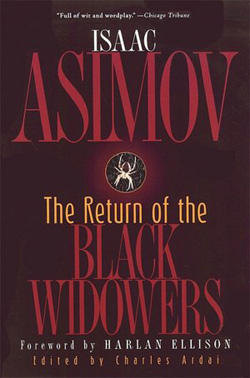
What’s probably not quite so well-known is that Asimov also wrote a number of mysteries. They comprise a small percentage of his massive total output, but number just over a dozen books in all. Many were short stories, but Asimov also wrote several respected novels that successfully melded science fiction and whodunits (The Caves of Steel, The Naked Sun).
Asimov was a member of the Sherlock Holmes fan organization, the Baker Street Irregulars, and the Wolfe Pack, a fan group convened to sing the praises of Rex Stout’s Nero Wolfe. But it’s his membership in another group, the Trap Door Spiders, that led to the creation of some of his most popular mystery stories. The Spiders, like their fictional counterparts, the Black Widowers, were an all-male group that convened regularly to eat, drink, discuss, debate and whatnot. Like Asimov, a number of the members of the Spiders were popular science fiction authors, including such notables as L. Sprague de Camp, Lin Carter and L. Ron Hubbard (in his pre-messianic incarnation).
The Black Widowers were six men from the upper strata of society. Much like the Spiders they would met every now and then for dinner—typically with a single guest on hand—and ended up solving some manner of puzzle presented to them by that guest. In most cases it’s the group’s unofficial seventh member who ends up solving the puzzle. Though his official role is to wait on the others, a role he’s quite content with, Henry commands the respect of everyone else in the group (who spend no small amount of time bickering with each other) and has rather keen insights into all of the issues that are presented.
 Asimov wrote 66 of these stories in all, most of which appeared in Ellery Queen’s Mystery Magazine. He began turning them out in 1971 and they were collected into five volumes during his lifetime, which finally ran its course in 1992. One more volume was released a little more than a decade later. It was called The Return of the Black Widowers and contained six previously uncollected stories by Asimov as well as ten of the highlights from the other five books. Other high points included a new Black Widowers story by Charles Ardai, editor of the book, a tribute by William Brittain, an introduction by Asimov’s friend, Harlan Ellison, and a snippet from Asimov’s autobiography, which talks about his creation of the Black Widowers.
Asimov wrote 66 of these stories in all, most of which appeared in Ellery Queen’s Mystery Magazine. He began turning them out in 1971 and they were collected into five volumes during his lifetime, which finally ran its course in 1992. One more volume was released a little more than a decade later. It was called The Return of the Black Widowers and contained six previously uncollected stories by Asimov as well as ten of the highlights from the other five books. Other high points included a new Black Widowers story by Charles Ardai, editor of the book, a tribute by William Brittain, an introduction by Asimov’s friend, Harlan Ellison, and a snippet from Asimov’s autobiography, which talks about his creation of the Black Widowers.
I greatly enjoyed the two volumes of Black Widowers’ stories I’ve read thus far, even though some of the puzzles tended to be farfetched or require specific knowledge that most of us don’t have. Having said that, I’d hasten to point out that they’re not for everyone. I’ve always had something of a weakness for that type of story within a story—often of the ghostly variety—where a group of well-heeled types sit around in a drawing room or similar environment and spin yarns. If you like your fiction with plenty of action then quite honestly these tales are probably not going to work for you. But as I concluded in my review of one of the books, “It’s all in good fun and if you like this sort of thing…well, then, you’ll like this sort of thing.”
Tales of the Black Widowers (1974)
More Tales of the Black Widowers (1976)
Casebook of the Black Widowers (1980)
Banquets of the Black Widowers (1984)
Puzzles of the Black Widowers (1990)
The Return of the Black Widowers (2003)
William I. Lengeman III is a freelance journalist with a fondness for gourmet tea and traditional mysteries. He writes about the former at Tea Guy Speaks and the latter at Traditional Mysteries.
Read all of William I. Lengeman III’s posts for Criminal Element.

Wow, I didn’t realize there were so many of those. They were light, but fun. Kind of popcorn.